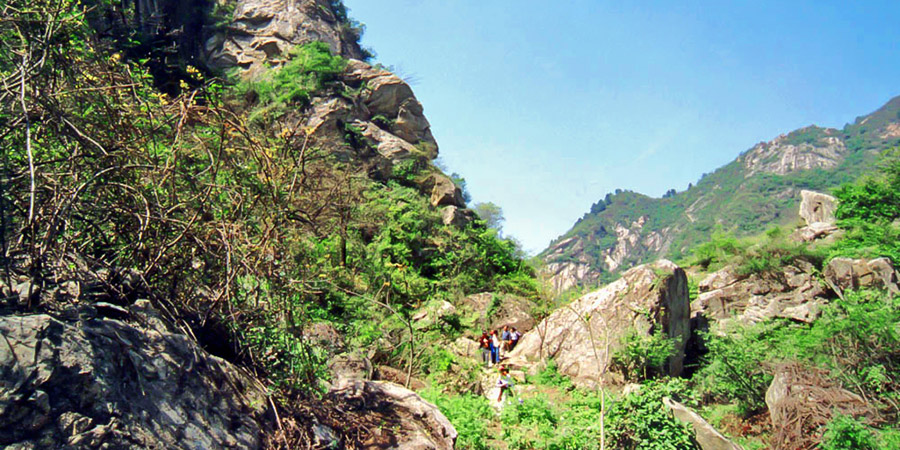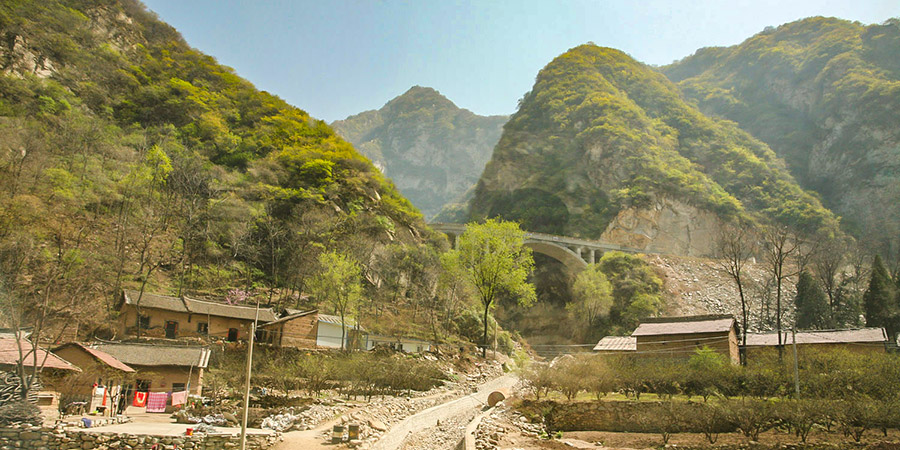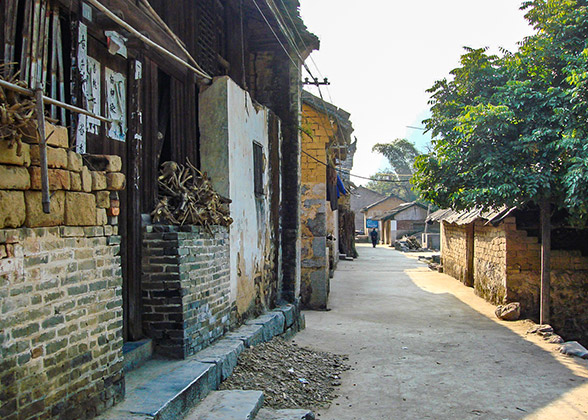Jingxi Ancient Road
Jingxi Ancient Road is not a single road, but a general name of many roads between Beijing downtown and the mountainous areas in the west suburb, even Inner Mongolia and Shanxi Province. They were very busy in ancient times, used to transport coal, and other items by horse, donkey, mule, and camel. Some of them were used by pilgrims to the temples in the west suburb to offer sacrifices. Although abandoned as time passes by, these bumpy roads have become historical relics for people to trace the past. Some of them also turn into popular trails among hiking lovers.
Jingxi Ancient Road is made up of many roads diversely. Even if the starting point and ending point are the same, there are different ways between. But the hiking difficulty is not very high in general, with both flat roads and winding steps. In addition, the traffic from or back to Beijing downtown is very convenient, making it a good destination for one-day hiking.
Route: Shiguyan Village – Wangping Town – Daoxu Village – East Magezhuang Village – West Magezhuang Village – Former Residence of Ma Zhiyuan in Jiuyuan Village – Sanyi Temple – Niujiaoling Pass – Longjiazhuang Village
 Distance: about 12km (7.5mi)
Distance: about 12km (7.5mi)
 Time Needed: 6 hours
Time Needed: 6 hours
 Highlights
Highlights
Wangping Ancient Road is the most beautiful and abundant among Jingxi Ancient Road. In addition to horse hoof prints, ancient stone road, ancient villages, one will also see Buddha carvings on the mountain cliff, ancient stores selling snacks and toilets for horses. Niujiaoling is an important pass on the ancient road, built with stones and bricks.
 How to Get There
How to Get There
Take subway line 1, Line 6 or line S1 to Pingguoyuan, then change to bus no. 929/M22/M6 to Shiguyan. The bus ride needs about 1.5 hours.
 How to Get Back to Beijing:
How to Get Back to Beijing:
From Longjiazhuang bus stop, take bus no. M7, M22 or 929 back to Pingguoyuan Subway Station in Beijing downtown. It may take an hour or so.
Route: Quanmen – Sandian Village – Tianqiaofu Village – Guanting Coal Mine – Fengkouan Pass – Horse Hoofprints – Radar Station - Longtan – Tanzhe Temple
 Distance: about 15km (9mi)
Distance: about 15km (9mi)
 Time needed: about 6-7 hours
Time needed: about 6-7 hours
 Features
Features
The current existing ancient road along this section is as long as 6.5km (4 mi), paved with stone plates. There are several sites especially worthy of your attentions. Quanmen was built above the road. Its halls were once used to worship the Gods in Chinese Taoism and the roofs are glazed with yellow and green tiles. Tianqiaofu Village preserves a temple and many forts left from Sino-Japanese War. Fengkouan is the “No.1 Pass on Yuhe ancient Road”, with a height of 5 meters (16.4 feet) and a width of 6 meters (19.7 feet).
About 200 meters (220 yards) to the west of Fengkouan and at the turning point of a mountain foot, there is a section of ancient road carved out of the mountain, with a length of 20 meters (22 yards) and a width of 1.5-2 meters (1.6-2.2 yards). On it, lies two rows of horse hoof prints accounting to nearly 100. Their diameter is about 20cm (8in) and depth varies from 10-15cm (5-6in). They may be the best preserved horse hoof prints along Jingxi Ancient Road. They quietly tell the prosperity of the ancient road.
Tanzhe Temple is one of the most famous temples to the west of Beijing both in history and nowadays and many branches of Ancient Jingxi Road led here. If time permits, you can pay a visit inside after the hiking.
 How to Get There
How to Get There
You also need to arrive at Pingguoyuan subway station by subway line 1, line 6 or line S1, then change to bus no. 370 to Quanmen directly.
 How to Get Back to Beijing
How to Get Back to Beijing
Nearby Tanzhe Temple, there is bus no. 931, which can transfer you back to Pingguoyuan subway station. The bus ride takes about 1.5 hours.
Route: Jietai Temple – Shifo Village – Jietaisi Country Park – Jietai Temple
 Distance: about 8km (5mi)
Distance: about 8km (5mi)
 Time needed: 3.5-4 hours
Time needed: 3.5-4 hours
 Highlights
Highlights
Jietai Temple is another famous temple to the west of Beijing, also the ending point of many Jingxi Ancient Road in history. However, the ancient road had been severely damaged and one can see a small section inside the nearby Jietaisi Country Park. Shifo Village was named so because of 18 Buddha statues carved on the mountain cliff nearby in the Ming Dynasty (1368 - 1644).
 How to Get There
How to Get There
After getting to Pingguoyuan subway station by subway line 1, line 6 or line S1, take bus no. 948 to Jietai Temple directly.
 How to Get Back to Beijing
How to Get Back to Beijing
reverse the coming way back to Beijing.
1. Wear a pair of comfortable hiking shoes. In some sections, you may need to use both your hands and feet, so bring a pair of gloves, too. Considering the long-distance hiking, you may also need a hiking stick.
2. Bring with you enough water, convenient food and some snacks which can quickly replenish energy like chocolates. There may not be restaurants along the trails.
3. If you are an independent traveler and not very familiar with the routes, you may go to Pingguoyuan Subway Station. Many hiking lovers gather there and depart for Jingxi Ancient Road hiking, especially on weekends and holidays. You may join one of the groups.
 |
| Jingxi Ancient Road |
Top Jingxi Ancient Road Hiking Trails
1. Wangping Ancient Road
|
|
Wangping Ancient Road is the most beautiful and abundant among Jingxi Ancient Road. In addition to horse hoof prints, ancient stone road, ancient villages, one will also see Buddha carvings on the mountain cliff, ancient stores selling snacks and toilets for horses. Niujiaoling is an important pass on the ancient road, built with stones and bricks.
Take subway line 1, Line 6 or line S1 to Pingguoyuan, then change to bus no. 929/M22/M6 to Shiguyan. The bus ride needs about 1.5 hours.
From Longjiazhuang bus stop, take bus no. M7, M22 or 929 back to Pingguoyuan Subway Station in Beijing downtown. It may take an hour or so.
2. Yuhe Ancient Road
The current existing ancient road along this section is as long as 6.5km (4 mi), paved with stone plates. There are several sites especially worthy of your attentions. Quanmen was built above the road. Its halls were once used to worship the Gods in Chinese Taoism and the roofs are glazed with yellow and green tiles. Tianqiaofu Village preserves a temple and many forts left from Sino-Japanese War. Fengkouan is the “No.1 Pass on Yuhe ancient Road”, with a height of 5 meters (16.4 feet) and a width of 6 meters (19.7 feet).
|
|
Tanzhe Temple is one of the most famous temples to the west of Beijing both in history and nowadays and many branches of Ancient Jingxi Road led here. If time permits, you can pay a visit inside after the hiking.
You also need to arrive at Pingguoyuan subway station by subway line 1, line 6 or line S1, then change to bus no. 370 to Quanmen directly.
Nearby Tanzhe Temple, there is bus no. 931, which can transfer you back to Pingguoyuan subway station. The bus ride takes about 1.5 hours.
3. Lutan Ancient Road
 |
| Shifo Village |
Jietai Temple is another famous temple to the west of Beijing, also the ending point of many Jingxi Ancient Road in history. However, the ancient road had been severely damaged and one can see a small section inside the nearby Jietaisi Country Park. Shifo Village was named so because of 18 Buddha statues carved on the mountain cliff nearby in the Ming Dynasty (1368 - 1644).
After getting to Pingguoyuan subway station by subway line 1, line 6 or line S1, take bus no. 948 to Jietai Temple directly.
reverse the coming way back to Beijing.
Jingxi Ancient Road Hiking Tips
2. Bring with you enough water, convenient food and some snacks which can quickly replenish energy like chocolates. There may not be restaurants along the trails.
3. If you are an independent traveler and not very familiar with the routes, you may go to Pingguoyuan Subway Station. Many hiking lovers gather there and depart for Jingxi Ancient Road hiking, especially on weekends and holidays. You may join one of the groups.
- Last updated on Nov. 28, 2024 by Zoey Gong -



